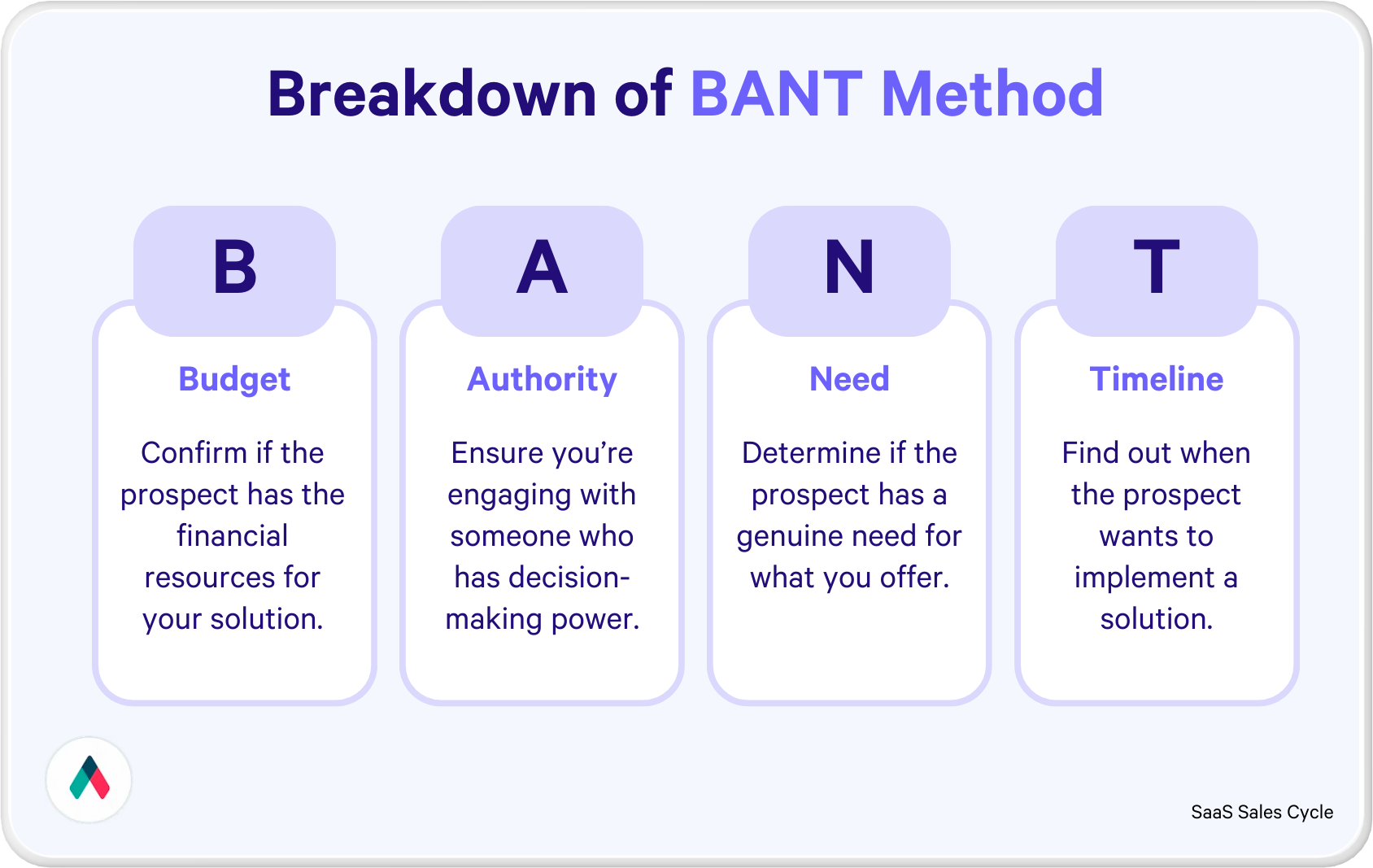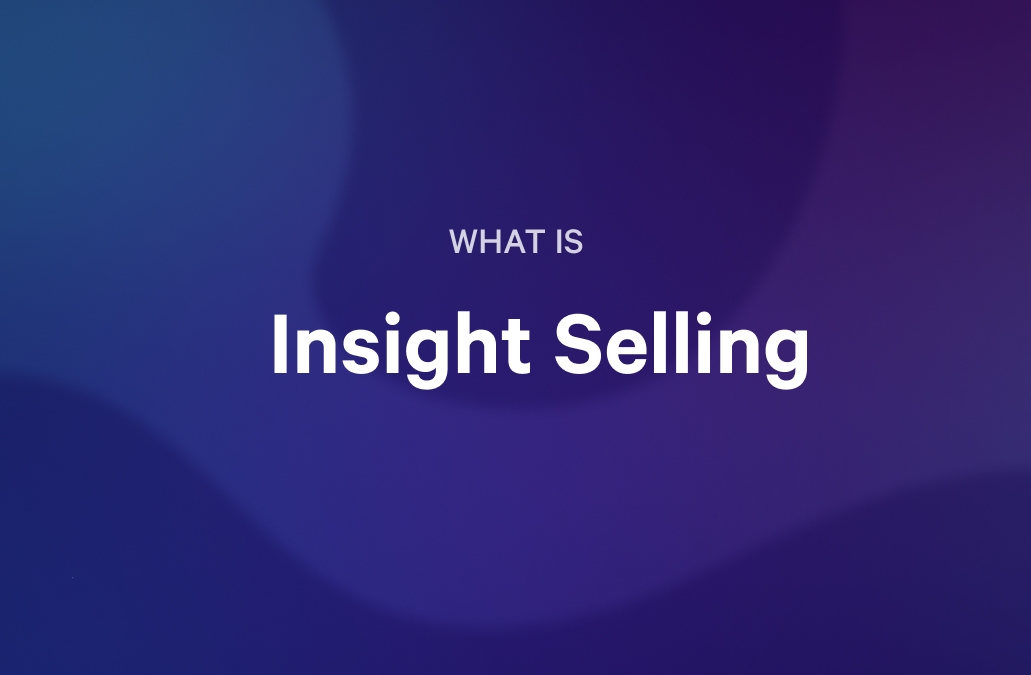Have you ever found yourself amidst a sea of potential leads, wondering which ones are ripe for the picking and which might lead you on a wild goose chase?
Qualifying leads swiftly and effectively is a challenge every sales leader faces—that juggling act of quantity and quality.
Imagine streamlining your lead qualification process to focus solely on the most promising prospects, effectively accelerating your sales cycle. This is where the BANT sales methodology comes in.
BANT stands for Budget, Authority, Need, and Timeline – four critical elements that can make or break a deal. Take a closer look at its transformative potential and the most effective ways to apply it in the modern sales landscape.
If you're not familiar with this framework, BANT sales was coined and popularized by IBM way back in the 1950s in an attempt to speed up their sales process on their road to world domination. The aim was to expedite what could be lengthy sales conversations, helping them focus their resources and efforts more effectively.
BANT overview
BANT stands for Budget, Authority, Needs, and Timing. Here’s a quick breakdown:
- Budget: Is your prospect able to afford your solution?
- Authority: Who has the power to say yes?
- Needs: What does your prospect truly need?
- Timing: Is now the right time for them to buy?
Understanding these elements can drastically shift the way you approach sales. It's not just about asking random questions; it's about asking the right questions that let you peek into the lives of your prospects to see if your product fits. Like finding the perfect puzzle piece that completes the picture, using BANT effectively means you're not just selling; you're solving a problem.
Over the years, the BANT sales framework has undergone a metamorphosis, adapting to a sales landscape moving beneath its feet. While its core principles have stood the test of time, the application has become more flexible, nuanced, and context-dependent- now serving more as a guide than a checklist. It still helps reps understand when sales leads are worth pursuing and when it might be better to walk away from a potential deal.
The components of BANT

Budget
In B2B sales, uncovering a prospect’s budget is not just about knowing if they can afford your product; it’s about understanding how your offerings fit within their financial landscape. Can they comfortably purchase a reasonable timeframe, or will it stretch their resources thin? Aligning your offerings with the prospect’s budget sets the stage for a transparent and grounded sales conversation, laying the foundation for a trust-based relationship.
Authority
Who's holding the reins? Knowing who has the authority ensures your efforts are channeled in the right direction and that your strategy is crafted to resonate most effectively with the decision-makers.
Need
As bright as that IBM team was, I’m assuming they couldn’t fashion an acronym here that began with N, because Need, of course, is first and foremost in the buying process!
When it comes to assessing needs, salespeople should be seeking to uncover the most pressing pain points. It’s not about pushing a product; it’s about presenting a solution that fits within the prospect’s timeline and most critical needs. When the prospect sees that you understand their challenges and have the perfect antidote, you can be assured you’ll have their full attention.
Timeline
Timing is everything. Understanding the prospect's timeline helps set the pace for your sales strategy. Effective navigation can be the difference between closing the deal and losing the prospect. Striking while the iron is hot with your product or service is the timely solution they’ve been searching for.
Advantages and disadvantages of BANT
The BANT framework’s impact and legacy are assured; however, it does have some drawbacks.
By assessing Budget, Authority, Need, and Timing, sales professionals can quickly determine if a prospect has the financial capacity, decision-making power, actual need for the product, and readiness to buy in the near term—key factors that traditionally signify a viable sales opportunity.
Traditionally, however, is the operative word there. Modern selling, not least in the B2B SaaS world, bears little relation to the 1950s when BANT came to prominence.
An average of seven stakeholders are now involved in most purchasing decisions- throwing a rather large spanner in the works of the Authority aspect. Not to mention the assumption that the salesperson has access to these decision-makers from an early stage in the process.
In this early stage, the budget is often unknown; it may not be finalized, defined, or disclosed.
BANT's rigidity and focus on the seller's perspective can make it less customer-centric, too- woefully out of step in a world where customers have so much choice and information at their fingertips, and what they want from sellers is now a more personalized approach. More ‘trusted advisor’ than what we think of as the archetypal ‘salesperson’ role.
BANT still has a time and place, for example, in a more transactional or SMB approach where the decision-maker is likely to be involved earlier, where the pricing may be minimal to start (i.e. more product-led growth), and where a more complex methodology is overkill. However, in today’s dynamic market, its principles must be seen more as signposts than a detailed map.
Comparing BANT with other sales frameworks
With many sales methodologies, it’s worth looking at how BANT stacks up against other prominent frameworks like MEDDIC, MEDDPICC, and SPIN.
BANT vs. MEDDIC
- BANT focuses on Budget, Authority, Need, and Timeline, which offers a straightforward lead qualification process.
- MEDDIC(Metrics, Economic Buyer, Decision Criteria, Decision Process, Identify Pain, Champion) dives deeper into the customer’s organization, examining their metrics for success and internal decision-making processes. MEDDIC often lends itself to more complex and larger enterprise sales where multiple factors influence the buying decision.
For a more detailed comparison, see our guide on BANT Vs. Meddic.
BANT vs. MEDDPICC
- MEDDPICC extends MEDDIC by including the Paper Process, Implications of Pain, and Competition, thus adding layers to the qualification that account for the broader impact of a purchase and competitive positioning.
- In contrast, BANT might overlook some of these subtler dynamics, such as the full implications of a client’s pain points or the specificities of their paper process, which can be critical in lengthy enterprise sales cycles.
BANT vs. SPIN
- SPIN (Situation, Problem, Implication, Need-payoff) is more of a conversational framework that helps sales reps navigate through a sales dialogue by asking the right questions.
- BANT, on the other hand, could be considered a more rigid qualification checklist. SPIN allows a deeper exploration of a client's problems and implications, potentially providing a more consultative sales approach.
Each framework has strengths, and the choice between them often depends on the sales context. BANT’s simplicity is well-suited for straightforward sales environments. MEDDIC, MEDDPICC, and SPIN cater to complex, layered sales scenarios where deeper insight into the customer’s business and a more nuanced understanding of their problems are crucial for success.
Questions to ask when using the BANT sales qualification framework
Imagine you're on a first date. You wouldn't jump right to the question of whether or not they see a future with you. It's too soon for that! Instead, you'd ask about their values, life goals, and (most importantly!) which box sets they like to gauge compatibility. Similarly, in sales, the right questions help you understand if your prospect's needs align with what you're offering without scaring them off or wasting anyone's time.
Budget
Question 1: "What budget have you allocated for this type of solution?"
This immediately clarifies whether the prospect has even considered the financial aspect of solving their problem. It's a straightforward way to understand if they're window shopping or ready to buy.
Question 2: "How does your company usually decide on budget allocations for new solutions?"
This question peels back another layer, giving you insight into their decision-making process. It can reveal constraints or flexibility you might work with.
Question 3: "Have you invested in similar solutions in the past, and how did those investments compare to the budget you're considering now?"
This helps benchmark their current mindset and past decisions against your offering. It's like understanding if they're used to shopping at luxury stores but are now browsing through a flea market (or vice versa).
The budget questions aim to paint a picture of financial readiness and constraints. They're your first clue in deciding if this lead can eventually become a successful sale.
Authority
Question 1: "Who will make the final decision on this project, and can they be part of our next discussion?"
This directly identifies the decision-maker. If you're not talking to them, you must know how and when you can. (Of course, this can be complicated in the world of modern selling, where an average of seven people are involved in most buying decisions).
Question 2: "What is the process for approving new vendors or solutions within your organization?"
This question helps you understand the bureaucracy or hurdles you might face, preparing you for the length of journey that lies ahead.
Question 3: "How have decisions on similar solutions been made in the past?"
Why ask this? It offers historical insight into their decision-making culture. You'll know if you're dealing with a monarchy, democracy, or complete anarchy.
Navigating through the Authority questions ensures you're spending your time wisely and talking to the right people in the right way.
Needs
Question 1: "Can you walk me through the challenges you're currently facing in this area?"
This open-ended question allows your prospect to share their struggles in their own words, providing you with insights into their pain points and how your solution could be a game-changer for them.
Question 2: "What does the ideal solution look like for you?"
This encourages the prospect to envision their perfect scenario, giving you a template for how to position your product or service as the key to achieving this ideal state.
Question 3: "How do you measure success for a solution in this area?"
Understanding their success criteria gives you the parameters within which you can demonstrate your solution's value, ensuring that what you're offering aligns with their expectations.
Question 4: "What's missing from your current solution or provider?"
This question uncovers gaps that your product or service might fill, highlighting opportunities for you to differentiate and position your offering as superior.
The "Needs" questions are part of your sales qualification process, illuminating your prospect's desires and requirements. They help you craft a narrative in which your solution is not just a nice-to-have but a must-have, addressing their specific challenges and aspirations.
Timing
Timing can be the deal-maker or breaker. It's all about finding out if the stars are aligning for your prospect to make a move now or if you're looking at a longer game.
Question 1: "What's your timeline for implementing a solution?"
This question helps set expectations on both sides. Knowing their timeline allows you to adjust your sales strategy accordingly, whether it means a fast track to a demo or a more nurtured, long-term approach.
Question 2: "Are there any upcoming events or deadlines driving your need for a solution?"
External pressures or opportunities can greatly influence the urgency of finding a solution. Understanding these can help you tailor your pitch to highlight how your solution can meet these timely needs.
Question 3: "What happens if you don't implement a solution within this timeframe?"
This question helps both you and the prospect to understand the stakes. It brings to light the consequences of inaction, which can be a powerful motivator for moving forward.
Question 4: "Have you considered what resources will be required to implement and manage this solution?"
Implementation isn't just about the decision to buy; it's also about the readiness to integrate and use your solution effectively. This question helps gauge their preparedness and possibly uncover any additional barriers to timing.
Asking the right "Timing" questions ensures that you're selling at the right time and helping your prospect buy at the right time. It's about synchronizing your watches, making sure that when you're ready to go, they are too.
Implementing BANT in a modern sales environment
Here, we’ll explore how BANT can be integrated into modern sales practices to maintain its relevance and effectiveness.
1: BANT in digital sales
Digital tools enable sales professionals to gather information about a prospect’s budget, authority, needs, and timeline in innovative ways. For instance, analytics tools can track a prospect's interaction with your website, providing insights into their level of interest and potential budget based on the products they are looking at. Social media and professional networks like LinkedIn make it easier to identify and connect with the decision-makers in an organization. Email and digital communication tools also provide a platform for asking BANT qualifying questions directly or indirectly, helping to gauge the prospect’s needs and timeline more efficiently.
2: Customizing BANT for flexibility
Modern sales require adaptability, and BANT can be tailored to fit different sales processes and industries. It’s crucial to recognize that the components of BANT don’t always have to follow a specific order or carry equal weight in every scenario. In some cases, understanding the prospect’s need might take precedence over knowing their budget, or establishing authority might be more straightforward than determining the timeline. The flexibility in applying BANT ensures it remains a valuable tool, even when the sales landscape shifts.
3: Combining BANT with other sales methodologies
BANT doesn’t have to stand alone. Combining it with other sales methodologies can enhance its effectiveness and provide a more comprehensive view of the prospect. For instance, integrating BANT with the Challenger Sales approach can lead to a more consultative selling process, where the sales rep not only qualifies the prospect but also challenges them to think differently, adding value to the interaction.
Implementing BANT in modern sales requires a blend of traditional and innovative approaches, ensuring that it can remain both relevant and effective.
Tools and technologies enhancing BANT
Having the right sales tools and technology at your disposal can significantly enhance the BANT process, providing a sharper edge in lead qualification. Let’s delve into some of the digital tools that can augment BANT, turning it into a powerhouse for your sales efforts.
CRM systems
Customer Relationship Management (CRM) systems are the linchpin in modern sales, acting as a central repository for all interactions with potential customers. Platforms like Salesforce, HubSpot, and Microsoft Dynamics allow sales teams to seamlessly capture and store BANT information.
Sales engagement platforms
Sales engagement platforms like Salesloft, Gong, and Outreach provide tools for automating and enhancing sales interactions, making the BANT process more efficient. Email templates can be used for BANT qualification and tracking responses and call analytics to analyze sales calls and identify mentions of budget, authority, need, or timeline.
Social selling tools
You can leverage social selling tools like LinkedIn Sales Navigator to identify and connect with the decision-makers within an organization, addressing the Authority component of BANT.
Analytics and data enrichment tools
Use analytics and data enrichment tools to gather additional information about your prospects, providing a fuller picture for BANT qualification. These can track how prospects interact with your website, which pages they visit, and how long they stay- providing insights into their need and potentially their budget. Data enrichment services can automatically populate your CRM with additional information about your prospects, helping to fill in any BANT gaps.
Integrating these tools not only streamlines the process but also provides a competitive edge, ensuring that your sales efforts are efficient and effective. Essentially, it brings the BANT method into the 21st century.
Final thoughts
BANT is a tool that, when used with finesse, reveals not just a prospect's viability but also the depth of their needs and the potential for a lasting partnership.
Its power lies not in the rigid adherence to its structure, but in the art of conversation, it fosters. It's about asking the right questions at the right time, in the right way. With BANT as your guide, you're not just closing deals but opening doors to new opportunities and relationships.
About the author

Marissa Taffer|Founder & President of M. Taffer Consulting
Marissa Taffer is the Founder & President of M. Taffer Consulting. She brings over 15 years of sales and marketing experience across various industries to a broad range of clients.
Frequently asked questions
Absolutely. But think of BANT less as a strict rulebook and more as a flexible guide. BANT works because it's adaptable; it allows you to gauge a prospect's readiness across key areas crucial for any sale: Budget, Authority, Needs, and Timing. The trick is not to use BANT as a checklist but as a conversation starter, a way to engage deeply with your prospects and understand their world better. When wielded with skill and sensitivity, BANT can illuminate the path to more sales and better, more meaningful customer relationships.
Indeed, it can. Modern sales are all about personalization, understanding, and building relationships. Some argue that BANT's sales methodology feels too transactional for today's nuanced sales landscape. However, when used correctly, BANT questions foster the exact kind of dialogue that modern buyers appreciate. They show that you're not only interested in making a sale but genuinely invested in solving a problem. BANT has evolved; it's not just about qualifying leads anymore but about building relationships.
Yes, but with a caveat. BANT's relevance can vary depending on the complexity of the sale, the sales cycle length, and whether you're in B2B or B2C sales. For straightforward, short-cycle B2C sales, the framework might need tweaking to keep the conversation flowing and relevant. In contrast, for complex B2B sales with longer cycles, BANT shines by providing a structured approach to understanding the multifaceted decision-making process. The key is to adapt BANT to your context, using it as a foundation upon which to build conversations that resonate with your specific audience.
It's all about the approach. The difference between a grilling session and a meaningful conversation lies in how you ask your BANT questions. The secret? Embed these questions within genuine, engaging discussions. Share insights, offer value, and listen actively. Make your prospect feel heard and understood, not just evaluated. It's not just what you ask but how you ask it that transforms BANT from an interrogation into an insightful exchange.



